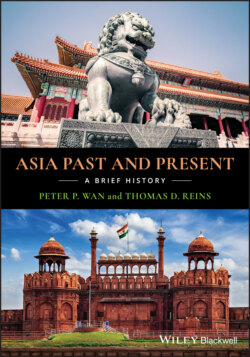Читать книгу Asia Past and Present - Peter P. Wan - Страница 22
Civilized Culture
ОглавлениеNo one knows for sure where or when civilization began, but most historians would today agree that it did not originate in Asia east of Afghanistan. As it stands at present, city life probably began in either Mesopotamia or Egypt sometime just after 4000 BCE. Perhaps further archaeological research will one day unearth evidence of earlier urban life elsewhere, conceivably in India, China, or another Asian location. Based on current scholarship, evidence of civilization in India can be traced back to roughly 3000 BCE and in China to about 2000 BCE, and there are other possible but as yet unverifiable sites that may have developed civilized ways even earlier. But it is fairly clear that it began as a result of farmers being pushed to the margins of land where rainfall became unreliable. A lack of water produced a search for it, and all four early civilizations—Mesopotamia, Egypt, India, and China—emerged along rivers flowing through terrain with minimal annual rainfall. Irrigation solved the water problem, at least temporarily.
Four river valley civilizations.
What is civilization? Typically civilization includes a cluster of characteristics. It is urban; has rudimentary bureaucratic government that operates with the aid of writing; and can impose and collect taxes, provide for the community’s defense, and dictate the community’s common agenda. Whatever the program, it would be carried out by a society divided by specialization, the most significant cause of inequality. At the top of the hierarchy would be the political leader, usually a monarch of some kind, who would be assisted by bureaucratic advisors and be given leadership legitimacy by a priesthood. Below these elites, urbanites of every description provided all sorts of goods and services. Merchants, artisans, engineers, police, clerks, laborers, shamans, and other occupations emerged to meet the demands principally of their urban neighbors. Urbanites also serviced the needs and wants of the rural population, whose surplus agricultural output supported the city dwellers.
The farmers produced enough food surpluses to support the urban population chiefly because engineers made available an abundance of water via irrigation works. Not only did rivers provide water, enabling farming to occur in an arid or semi‐arid environment, but also these natural waterways regularly flooded, depositing fresh topsoil on farmland, thereby swelling the agricultural output. Moreover, the constant reinvigoration of the fields by routine flooding eliminated the farmer’s need to find new fertile fields. In the beginning, at least, civilized life seemed to generate win‐win situations. True, not everyone was relatively equal as in Paleolithic, Neolithic, or Pastoral Nomadic times, but during early Civilized times everyone’s standard of living had vastly increased. And as established civilizations developed and new civilizations emerged, ways of life within an urban culture produced a diversity of occupations and outlooks. The differences between civilizations also substantially diverged, producing distinctively remarkable uniqueness that resulted in some civilizations being more complex, prosperous, inventive, and enduring, while others either did less well or came to emulate many of the ways of their more successful neighbors. By the advent of Chinese civilization, some 25 to 35 million human beings inhabited the earth, most living in Asia. Only a small percentage of the world’s population lived in civilized cultures at that time. Gradually, however, most people would come to reside within the compass of Civilized societies, while Paleolithic, Neolithic, and Pastoral Nomadic peoples steadily became part of marginal ways of life.
